Weiwen Xu
FINEREASON: Evaluating and Improving LLMs' Deliberate Reasoning through Reflective Puzzle Solving
Feb 27, 2025Abstract:Many challenging reasoning tasks require not just rapid, intuitive responses, but a more deliberate, multi-step approach. Recent progress in large language models (LLMs) highlights an important shift from the "System 1" way of quick reactions to the "System 2" style of reflection-and-correction problem solving. However, current benchmarks heavily rely on the final-answer accuracy, leaving much of a model's intermediate reasoning steps unexamined. This fails to assess the model's ability to reflect and rectify mistakes within the reasoning process. To bridge this gap, we introduce FINEREASON, a logic-puzzle benchmark for fine-grained evaluation of LLMs' reasoning capabilities. Each puzzle can be decomposed into atomic steps, making it ideal for rigorous validation of intermediate correctness. Building on this, we introduce two tasks: state checking, and state transition, for a comprehensive evaluation of how models assess the current situation and plan the next move. To support broader research, we also provide a puzzle training set aimed at enhancing performance on general mathematical tasks. We show that models trained on our state checking and transition data demonstrate gains in math reasoning by up to 5.1% on GSM8K.
Chain of Ideas: Revolutionizing Research Via Novel Idea Development with LLM Agents
Oct 25, 2024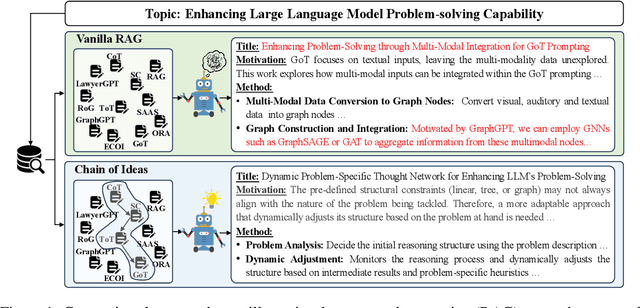

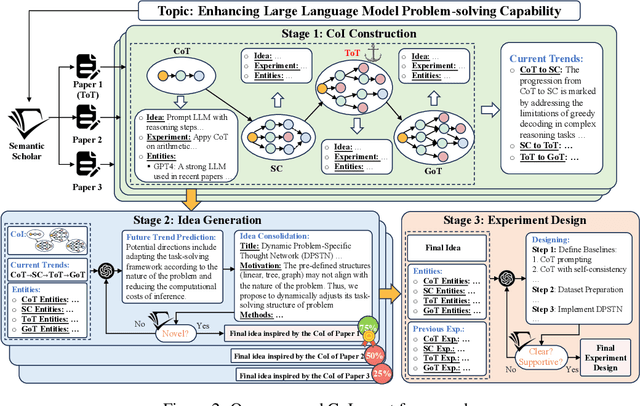

Abstract:Effective research ideation is a critical step for scientific research. However, the exponential increase in scientific literature makes it challenging for researchers to stay current with recent advances and identify meaningful research directions. Recent developments in large language models~(LLMs) suggest a promising avenue for automating the generation of novel research ideas. However, existing methods for idea generation either trivially prompt LLMs or directly expose LLMs to extensive literature without indicating useful information. Inspired by the research process of human researchers, we propose a Chain-of-Ideas~(CoI) agent, an LLM-based agent that organizes relevant literature in a chain structure to effectively mirror the progressive development in a research domain. This organization facilitates LLMs to capture the current advancements in research, thereby enhancing their ideation capabilities. Furthermore, we propose Idea Arena, an evaluation protocol that can comprehensively evaluate idea generation methods from different perspectives, aligning closely with the preferences of human researchers. Experimental results indicate that the CoI agent consistently outperforms other methods and shows comparable quality as humans in research idea generation. Moreover, our CoI agent is budget-friendly, with a minimum cost of \$0.50 to generate a candidate idea and its corresponding experimental design.
Chain of Ideas: Revolutionizing Research in Novel Idea Development with LLM Agents
Oct 17, 2024



Abstract:Effective research ideation is a critical step for scientific research. However, the exponential increase in scientific literature makes it challenging for researchers to stay current with recent advances and identify meaningful research directions. Recent developments in large language models~(LLMs) suggest a promising avenue for automating the generation of novel research ideas. However, existing methods for idea generation either trivially prompt LLMs or directly expose LLMs to extensive literature without indicating useful information. Inspired by the research process of human researchers, we propose a Chain-of-Ideas~(CoI) agent, an LLM-based agent that organizes relevant literature in a chain structure to effectively mirror the progressive development in a research domain. This organization facilitates LLMs to capture the current advancements in research, thereby enhancing their ideation capabilities. Furthermore, we propose Idea Arena, an evaluation protocol that can comprehensively evaluate idea generation methods from different perspectives, aligning closely with the preferences of human researchers. Experimental results indicate that the CoI agent consistently outperforms other methods and shows comparable quality as humans in research idea generation. Moreover, our CoI agent is budget-friendly, with a minimum cost of \$0.50 to generate a candidate idea and its corresponding experimental design.
Reasoning Paths Optimization: Learning to Reason and Explore From Diverse Paths
Oct 07, 2024Abstract:Advanced models such as OpenAI o1 exhibit impressive problem-solving capabilities through step-by-step reasoning. However, they may still falter on more complex problems, making errors that disrupt their reasoning paths. We attribute this to the expansive solution space, where each step has the risk of diverging into mistakes. To enhance language model reasoning, we introduce a specialized training framework called Reasoning Paths Optimization (RPO), which enables learning to reason and explore from diverse paths. Our approach encourages favorable branches at each reasoning step while penalizing unfavorable ones, enhancing the model's overall problem-solving performance. Reasoning Paths Optimization does not rely on large-scale human-annotated rationales or outputs from closed-source models, making it scalable and data-efficient. We focus on multi-step reasoning tasks, such as math word problems and science-based exam questions. The experiments demonstrate that our framework significantly enhances the reasoning performance of large language models, with up to 3.1% and 4.3% improvement on GSM8K and MMLU (STEM) respectively. Our data and code can be found at https://reasoning-paths.github.io.
Can We Further Elicit Reasoning in LLMs? Critic-Guided Planning with Retrieval-Augmentation for Solving Challenging Tasks
Oct 02, 2024Abstract:State-of-the-art large language models (LLMs) exhibit impressive problem-solving capabilities but may struggle with complex reasoning and factual correctness. Existing methods harness the strengths of chain-of-thought and retrieval-augmented generation (RAG) to decompose a complex problem into simpler steps and apply retrieval to improve factual correctness. These methods work well on straightforward reasoning tasks but often falter on challenging tasks such as competitive programming and mathematics, due to frequent reasoning errors and irrelevant knowledge retrieval. To address this, we introduce Critic-guided planning with Retrieval-augmentation, CR-Planner, a novel framework that leverages fine-tuned critic models to guide both reasoning and retrieval processes through planning. CR-Planner solves a problem by iteratively selecting and executing sub-goals. Initially, it identifies the most promising sub-goal from reasoning, query generation, and retrieval, guided by rewards given by a critic model named sub-goal critic. It then executes this sub-goal through sampling and selecting the optimal output based on evaluations from another critic model named execution critic. This iterative process, informed by retrieved information and critic models, enables CR-Planner to effectively navigate the solution space towards the final answer. We employ Monte Carlo Tree Search to collect the data for training the critic models, allowing for a systematic exploration of action sequences and their long-term impacts. We validate CR-Planner on challenging domain-knowledge-intensive and reasoning-heavy tasks, including competitive programming, theorem-driven math reasoning, and complex domain retrieval problems. Our experiments demonstrate that CR-Planner significantly outperforms baselines, highlighting its effectiveness in addressing challenging problems by improving both reasoning and retrieval.
SeaLLMs 3: Open Foundation and Chat Multilingual Large Language Models for Southeast Asian Languages
Jul 29, 2024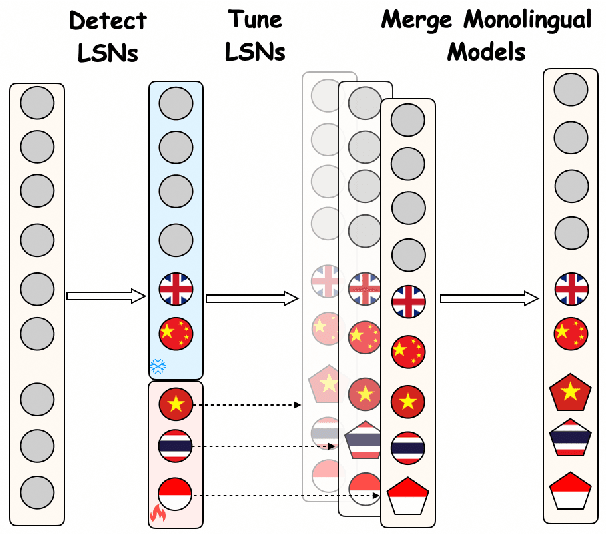
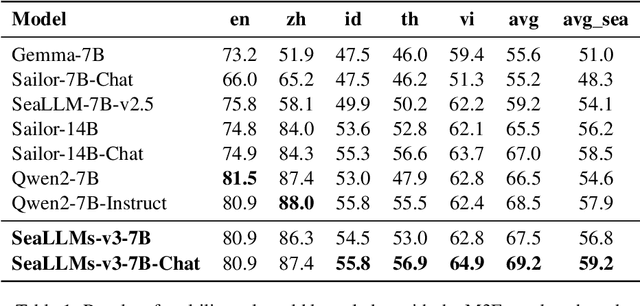
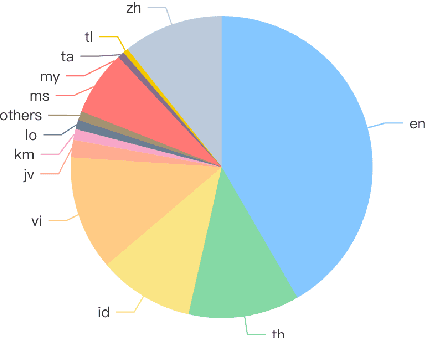
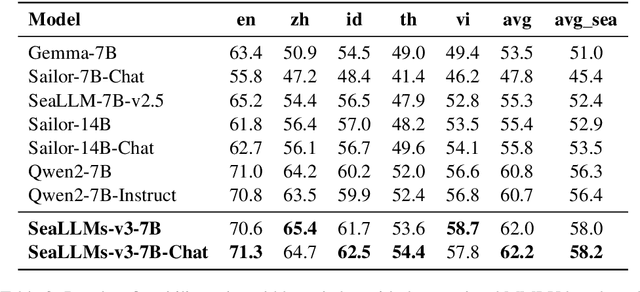
Abstract:Large Language Models (LLMs) have shown remarkable abilities across various tasks, yet their development has predominantly centered on high-resource languages like English and Chinese, leaving low-resource languages underserved. To address this disparity, we present SeaLLMs 3, the latest iteration of the SeaLLMs model family, tailored for Southeast Asian languages. This region, characterized by its rich linguistic diversity, has lacked adequate language technology support. SeaLLMs 3 aims to bridge this gap by covering a comprehensive range of languages spoken in this region, including English, Chinese, Indonesian, Vietnamese, Thai, Tagalog, Malay, Burmese, Khmer, Lao, Tamil, and Javanese. Leveraging efficient language enhancement techniques and a specially constructed instruction tuning dataset, SeaLLMs 3 significantly reduces training costs while maintaining high performance and versatility. Our model excels in tasks such as world knowledge, mathematical reasoning, translation, and instruction following, achieving state-of-the-art performance among similarly sized models. Additionally, we prioritized safety and reliability by addressing both general and culture-specific considerations and incorporated mechanisms to reduce hallucinations. This work underscores the importance of inclusive AI, showing that advanced LLM capabilities can benefit underserved linguistic and cultural communities.
On the Transformations across Reward Model, Parameter Update, and In-Context Prompt
Jun 24, 2024Abstract:Despite the general capabilities of pre-trained large language models (LLMs), they still need further adaptation to better serve practical applications. In this paper, we demonstrate the interchangeability of three popular and distinct adaptation tools: parameter updating, reward modeling, and in-context prompting. This interchangeability establishes a triangular framework with six transformation directions, each of which facilitates a variety of applications. Our work offers a holistic view that unifies numerous existing studies and suggests potential research directions. We envision our work as a useful roadmap for future research on LLMs.
Reasons to Reject? Aligning Language Models with Judgments
Dec 22, 2023Abstract:As humans, we consistently engage in interactions with our peers and receive feedback in the form of natural language. This language feedback allows us to reflect on our actions, maintain appropriate behavior, and rectify our errors. The question arises naturally: can we use language feedback to align large language models (LLMs)? In contrast to previous research that aligns LLMs with reward or preference data, we present the first systematic exploration of alignment through the lens of language feedback (i.e., judgment). We commence with an in-depth investigation of potential methods that can be adapted for aligning LLMs with judgments, revealing that these methods are unable to fully capitalize on the judgments. To facilitate more effective utilization of judgments, we propose a novel framework, Contrastive Unlikelihood Training (CUT), that allows for fine-grained inappropriate content detection and correction based on judgments. Our offline alignment results show that, with merely 1317 off-the-shelf judgment data, CUT (LLaMA2-13b) can beat the 175B DaVinci003 and surpass the best baseline by 52.34 points on AlpacaEval. The online alignment results demonstrate that CUT can align LLMs (LLaMA2-chat-13b) in an iterative fashion using model-specific judgment data, with a steady performance improvement from 81.09 to 91.36 points on AlpacaEval. Our analysis further suggests that judgments exhibit greater potential than rewards for LLM alignment and warrant future research.
mPMR: A Multilingual Pre-trained Machine Reader at Scale
May 23, 2023Abstract:We present multilingual Pre-trained Machine Reader (mPMR), a novel method for multilingual machine reading comprehension (MRC)-style pre-training. mPMR aims to guide multilingual pre-trained language models (mPLMs) to perform natural language understanding (NLU) including both sequence classification and span extraction in multiple languages. To achieve cross-lingual generalization when only source-language fine-tuning data is available, existing mPLMs solely transfer NLU capability from a source language to target languages. In contrast, mPMR allows the direct inheritance of multilingual NLU capability from the MRC-style pre-training to downstream tasks. Therefore, mPMR acquires better NLU capability for target languages. mPMR also provides a unified solver for tackling cross-lingual span extraction and sequence classification, thereby enabling the extraction of rationales to explain the sentence-pair classification process.
From Clozing to Comprehending: Retrofitting Pre-trained Language Model to Pre-trained Machine Reader
Dec 09, 2022Abstract:We present Pre-trained Machine Reader (PMR), a novel method to retrofit Pre-trained Language Models (PLMs) into Machine Reading Comprehension (MRC) models without acquiring labeled data. PMR is capable of resolving the discrepancy between model pre-training and downstream fine-tuning of existing PLMs, and provides a unified solver for tackling various extraction tasks. To achieve this, we construct a large volume of general-purpose and high-quality MRC-style training data with the help of Wikipedia hyperlinks and design a Wiki Anchor Extraction task to guide the MRC-style pre-training process. Although conceptually simple, PMR is particularly effective in solving extraction tasks including Extractive Question Answering and Named Entity Recognition, where it shows tremendous improvements over previous approaches especially under low-resource settings. Moreover, viewing sequence classification task as a special case of extraction task in our MRC formulation, PMR is even capable to extract high-quality rationales to explain the classification process, providing more explainability of the predictions.
 Add to Chrome
Add to Chrome Add to Firefox
Add to Firefox Add to Edge
Add to Edge